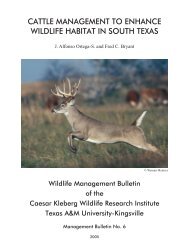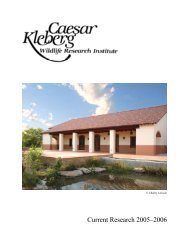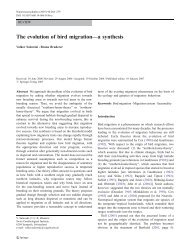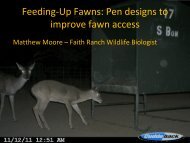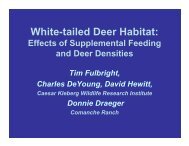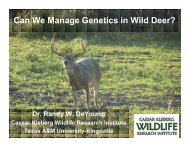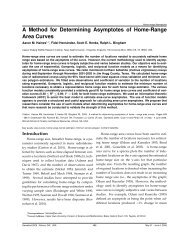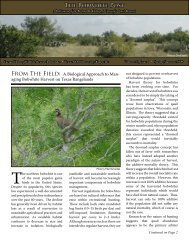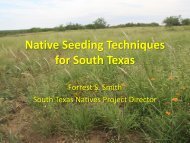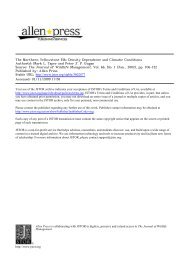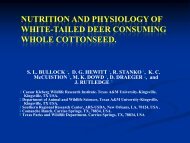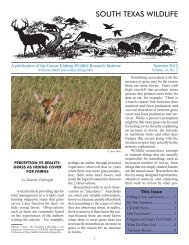South Texas Natives - Caesar Kleberg Wildlife Research Institute ...
South Texas Natives - Caesar Kleberg Wildlife Research Institute ...
South Texas Natives - Caesar Kleberg Wildlife Research Institute ...
You also want an ePaper? Increase the reach of your titles
YUMPU automatically turns print PDFs into web optimized ePapers that Google loves.
disturbances may help impede invasion<br />
by non-native species, control soil<br />
erosion, and prepare the soil for later<br />
establishment of other more desirable<br />
native species. The greatest potential<br />
use of Dilley is for highway rightof-way<br />
reseeding. The low growth<br />
form of the grass should help reduce<br />
mowing costs, and quick establishment<br />
characteristics adequately meet TxDOT<br />
requirements. Frequent mowing of<br />
slender grama does not seem to affect<br />
its longevity. Dilley may also have use<br />
in residential and urban settings for<br />
high-traffic areas and as an attractive,<br />
extremely drought tolerant ornamental<br />
native grass.<br />
Foundation seed of Dilley is currently<br />
available to commercial seed<br />
producers. Seed for public purchase<br />
will be available spring 2008. We<br />
believe that Dilley will be extremely<br />
useful to a variety of consumers, and<br />
feel that its use in place of exotic species<br />
will be an excellent testimony to<br />
the importance and further development<br />
of more valuable native plant<br />
resources.<br />
Forrest Smith is the Manager of Native Plant<br />
Collections and Evaluations for STN.<br />
Munda, B.D. and M.J. Pater. 2003 Revegetation<br />
practices on the Santa Rita<br />
Experimental Range. USDA Forest<br />
Service Proceedings RMRS-P-30.<br />
United States Department of Agriculture.<br />
2007. PLANTS Database. http://<br />
plants.usda.gov/.<br />
The Progress of Native Plant<br />
Restoration in Buffelgrass<br />
By Aaron Tjelmeland<br />
In the last 50 years, exotic grasses<br />
have become as much a part of the<br />
south <strong>Texas</strong> landscape as prickly pear<br />
cactus and mesquite. The impact of<br />
these grasses on native plants and wildlife<br />
has been significant and varies by<br />
species. Some species remain more<br />
or less where they’re planted, while<br />
others readily invade areas where they<br />
were not planted and are referred to<br />
as “invasive exotics”. Our research<br />
focuses on buffelgrass, an African<br />
grass brought to south <strong>Texas</strong> in the<br />
1940s.<br />
Since the introduction of buffelgrass,<br />
an estimated 9.8 million acres<br />
of south <strong>Texas</strong> has been converted<br />
to this exotic grass. The colonization<br />
of buffelgrass is aided by soil<br />
disturbance, such as disking or root<br />
plowing, near seed sources. Buffelgrass<br />
appears to invade aggressively<br />
in certain environments, but not in<br />
others. Once established, buffelgrass<br />
is frequently able to out-compete<br />
native plants, especially on heavy clay<br />
loam soils. It can also support a fire<br />
cycle that favors its propagation and<br />
survival. Furthermore, a study completed<br />
in 2002 found that a mixture of<br />
exotic grasses, including buffelgrass,<br />
reduced the abundance of bobwhite<br />
quail and other grassland birds, as<br />
well as insects, which are important<br />
quail food items.<br />
We initiated a series of studies<br />
focused on restoration and diversification<br />
of areas dominated by buffelgrass.<br />
The first of these studies was initiated<br />
in 2002, which utilized several herbicides<br />
in an attempt to establish several<br />
native grass species within a buffelgrass<br />
pasture. Although all areas eventually<br />
returned to buffelgrass within<br />
2 years, results of this early research<br />
References<br />
Correll, D.V., and M.S. Johnston. 1996.<br />
Manual of the Vascular Plants of <strong>Texas</strong>.<br />
The University of <strong>Texas</strong> at Dallas.<br />
Dallas, <strong>Texas</strong>. Fourth Printing.<br />
Everitt, J.H., C.L. Gonzalez, G. Scott, and<br />
B.I. Dahl. 1981. Seasonal food preferences<br />
of cattle on native range in the<br />
<strong>South</strong> <strong>Texas</strong> Plains. J. Range Management.<br />
34:384–388.<br />
Gonzalez C.L. and J.H. Everitt. 1982. Nutrient<br />
contents of major food plants eaten<br />
by cattle in the <strong>South</strong> <strong>Texas</strong> Plains. J.<br />
Range Management. 35(6):733–736.<br />
Gould, F.W. 1975. The Grasses of <strong>Texas</strong>.<br />
<strong>Texas</strong> A&M University Press. College<br />
Station, <strong>Texas</strong>.<br />
Lonard, R.I. 1993. Guide to the Grasses of<br />
the Lower Rio Grande Valley, <strong>Texas</strong>.<br />
The University of <strong>Texas</strong>-Pan American<br />
Press, Edinburg <strong>Texas</strong>.<br />
Aaron Tjelmeland inspecting Buffelgrass<br />
© Timothy Fulbright<br />
3



